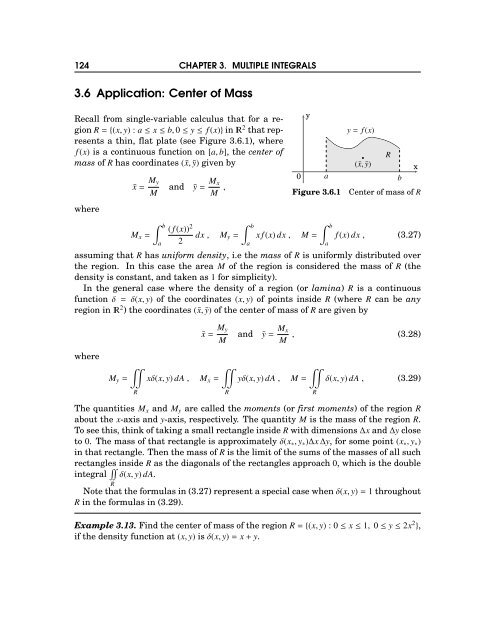Michael Corral: Vector Calculus
Michael Corral: Vector Calculus
Michael Corral: Vector Calculus
You also want an ePaper? Increase the reach of your titles
YUMPU automatically turns print PDFs into web optimized ePapers that Google loves.
124 CHAPTER 3. MULTIPLE INTEGRALS<br />
3.6 Application: Center of Mass<br />
Recall from single-variable calculus that for a regionR={(x,y)<br />
: a≤ x≤b,0≤y≤ f(x)}in 2 thatrepresents<br />
a thin, flat plate (see Figure 3.6.1), where<br />
f(x) is a continuous function on [a,b], the center of<br />
mass of R has coordinates (¯x,ȳ) given by<br />
where<br />
¯x= M y<br />
M and ȳ= M x<br />
M ,<br />
y<br />
y= f(x)<br />
R<br />
(¯x,ȳ) x<br />
0 a b<br />
Figure 3.6.1 Center of mass of R<br />
M x =<br />
∫ b<br />
a<br />
(f(x)) 2<br />
dx, M y =<br />
2<br />
∫ b<br />
a<br />
xf(x)dx, M=<br />
∫ b<br />
a<br />
f(x)dx, (3.27)<br />
assuming that R has uniform density, i.e the mass of R is uniformly distributed over<br />
the region. In this case the area M of the region is considered the mass of R (the<br />
density is constant, and taken as 1 for simplicity).<br />
In the general case where the density of a region (or lamina) R is a continuous<br />
functionδ = δ(x,y) of the coordinates (x,y) of points inside R (where R can be any<br />
region in 2 ) the coordinates (¯x,ȳ) of the center of mass of R are given by<br />
¯x= M y<br />
M and ȳ= M x<br />
M , (3.28)<br />
where<br />
<br />
M y =<br />
<br />
xδ(x,y)dA, M x =<br />
<br />
yδ(x,y)dA, M=<br />
δ(x,y)dA, (3.29)<br />
R<br />
R<br />
R<br />
The quantities M x and M y are called the moments (or first moments) of the region R<br />
about the x-axis and y-axis, respectively. The quantity M is the mass of the region R.<br />
To see this, thinkof taking asmall rectangleinsideRwith dimensions∆x and∆y close<br />
to 0. The mass of that rectangle is approximatelyδ(x ∗ ,y ∗ )∆x∆y, for some point (x ∗ ,y ∗ )<br />
in that rectangle. Then the mass of R is the limit of the sums of the masses of all such<br />
rectangles inside R as the diagonals of the rectangles approach 0, which is the double<br />
integral δ(x,y)dA.<br />
R<br />
Notethattheformulasin(3.27)representaspecialcasewhenδ(x,y)=1throughout<br />
R in the formulas in (3.29).<br />
Example 3.13. Find the center of mass of the region R={(x,y) : 0≤ x≤1, 0≤y≤2x 2 },<br />
if the density function at (x,y) isδ(x,y)= x+y.








